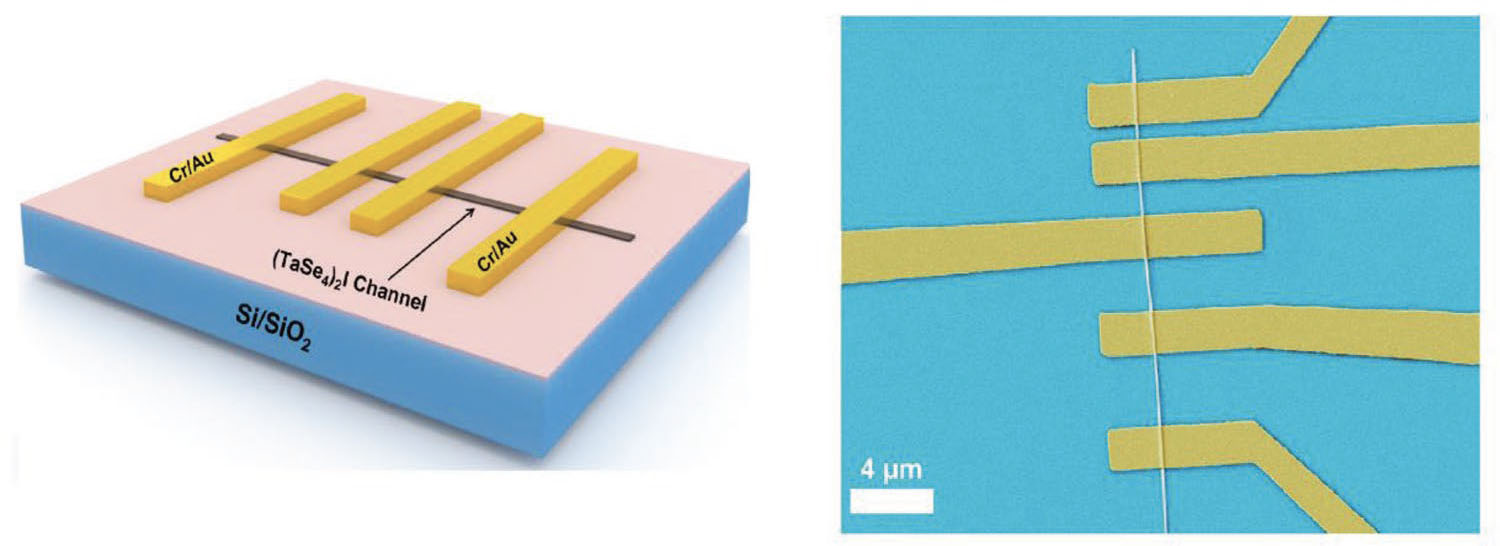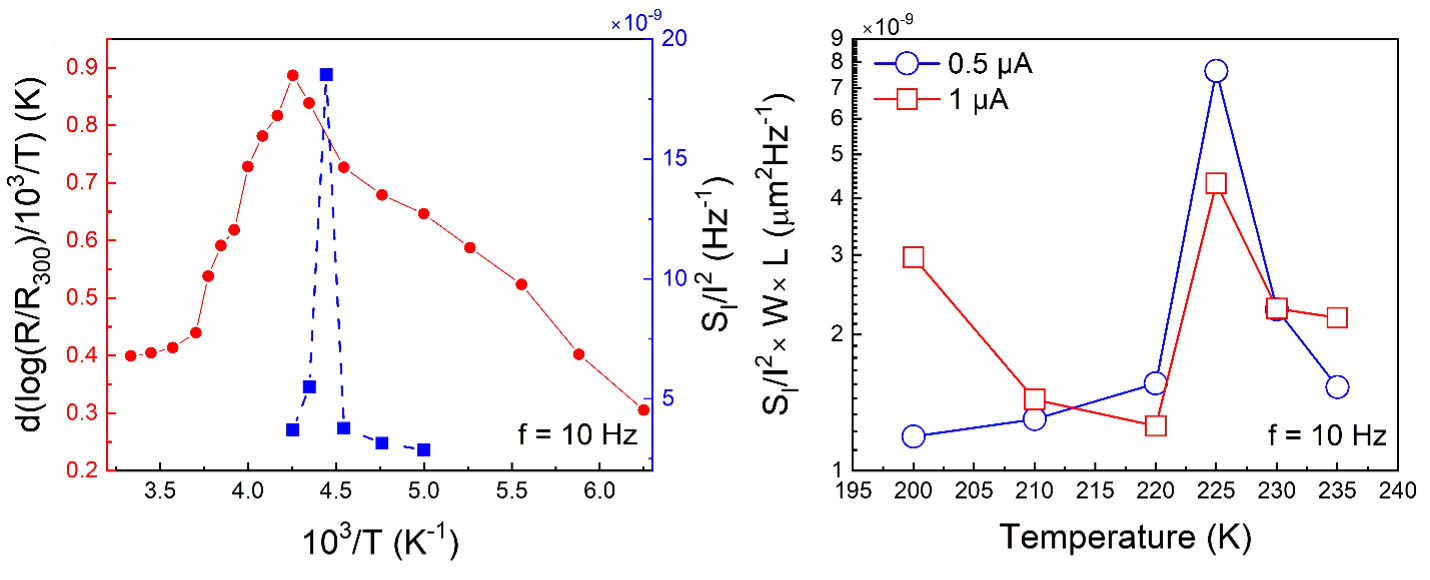| Nov 22, 2022 | |
One-dimensional Weyl semimetals as unique topological materials for future electronics |
|
| (Nanowerk Spotlight) Topology is the branch of mathematics that explores the nature of shapes independent of deformation. Physicists developed the concept of the phases of matter with properties that are defined by the topology rather than the size and shape of the material or impurities. | |
| Recent investigations suggest that topological semimetals reveal unique properties that can enable unprecedented functionalities for future electronics. An example of a topological semimetal – termed Weyl semimetal – is a van der Waals layered tetra-selenide compound (TaSe4)2I with a quasi-one-dimensional (1D) crystal structure. In 1D van der Waals materials, the atoms are strongly bonded in one direction and weakly in others. | |
| This specific 1D quantum material is defined as a Weyl semimetal with the charge-density-wave phase. The quantum charge-density-wave phase consists of a periodic modulation of the electronic charge density accompanied by a periodic distortion of the atomic lattice. The latter coupled with topology gives this material its unique properties. | |
| It has been previously suggested that the exotic topological Weyl semimetals have properties that will allow their future use in detectors for dark matter in the universe. In more near-term applications, the topological Weyl semimetals have been proposed as interconnects in next-generation electronics. | |
| The resistance and current density bottlenecks in downscaled metal interconnects motivate the search for new materials for interconnect applications. There are indications that in some topological semimetals, the electrical conductivity can increase as the cross-sectional area decreases, which is the opposite trend of conventional elemental metals such as copper. The interconnect applications also require a low level of electronic noise so that it does not interfere with the signal. | |
| In recent work, a research team led by Distinguished Professor Alexander A. Balandin, Department of Electrical and Computer Engineering, University of California, Riverside (UCR), reported the results of the first study of the electronic current fluctuations, i.e. noise, in prototype interconnects made of the topological Weyl semimetal (TaSe4)2I (see Figure 1). | |
| The results have been reported in the journal Advanced Electronic Materials ("Low-Frequency Current Fluctuations in Quasi-1D (TaSe4)2I Weyl Semimetal Nanoribbons"). | |
| The first author of the paper, who built and tested the devices, Dr. Subhajit Ghosh is a Postdoctoral Researcher in Balandin’s Nano-Device Laboratory (NDL) and the Phonon Optimized Engineered Materials (POEM) Center. He obtained his Ph.D. degree under Professor Balandin’s supervision, studying low-frequency noise in various materials and devices. | |
 |
|
| Figure 1: Schematic of a (TaSe4)2I interconnect test structure on Si/SiO2 substrate (left panel). Scanning electron microscopy image of a (TaSe4)2I test structure with varying channel lengths from 1 µm to 4 µm. Pseudo-colors are used for clarity. (The figure is courtesy of Dr. Subhajit Ghosh and Professor Alexander Balandin) | |
| “This quasi-one-dimensional quantum material is an exciting system for examining new functionalities and electronic applications,” explains Balandin. “This is just the beginning of the study to answer many interesting questions. Is electron transport in the topological Weyl semimetals characterized by inherently lower noise owing to the suppression of certain electron scattering mechanisms? Can one use the electronic noise data to verify the charge-density-wave transitions in the topological Weyl semimetals? Is the electronic noise in Weyl semimetals low enough for interconnect applications?” | |
| The researchers found that the electronic noise level in nanoribbons of this Weyl semimetal was surprisingly low, ∼10-9 µm2Hz-1 at f=10 Hz, when measured away from the charge-density-wave transition temperature. On the other side, the noise increased the phase transition temperature by almost an order of magnitude (see Figure 2). | |
 |
|
| Figure 2: Temperature-dependent electrical and low-frequency noise characteristics of a (TaSe4)2I prototype interconnect. Logarithmic derivative, d(log([R/R300])/d(103/T), vs. inverse temperature of the topological Weyl interconnect (left panel). Normalized noise current spectral density as a function of temperatures near the charge-density-wave phase transition temperature (right panel). (The figure is courtesy of Dr. Subhajit Ghosh and Professor Alexander Balandin) | |
| The results obtained by the team shed light on the specifics of electron transport in quasi-one-dimensional topological Weyl semimetals and can be important for their proposed applications as downscaled interconnects. | |
| “Our results also demonstrate the power of noise spectroscopy for monitoring phase transitions between the strongly correlated phases of one-dimensional quantum materials,” adds Balandin. | |
| Apart from investigating the physics of the electronic transport in such unique materials with noise spectroscopy, the team is also planning to address future interconnect applications of the Weyl semimetals. | |
| When the interconnect line-width scales below the electron mean free path, its resistivity increases in a power-law function due to increased electron scattering from interfaces and grain boundaries. This problem is persistent for all elemental metals, including copper and cobalt. There are indications that topological semimetals may overcome this problem, and the latter serves as a strong driver for continuing research of one-dimensional quantum materials. Other motivations come from the use of low-frequency noise as a materials quality and device reliability metric. | |
| “It is known that low-frequency noise can be an early indicator of damage to materials and devices,” explains Balandin. | |
| With the device or interconnect degradation, the noise increases at a much faster rate than the changes in the averaged current-voltage characteristics. The latter makes the noise a sensitive predictor of the device’s lifetime. The results obtained in this work can be used for developing assessment methodologies for the reliability of topological semimetals. | |
| Provided by the University of California, Riverside | |
|
Become a Spotlight guest author! Join our large and growing group of guest contributors. Have you just published a scientific paper or have other exciting developments to share with the nanotechnology community? Here is how to publish on nanowerk.com. |
|
